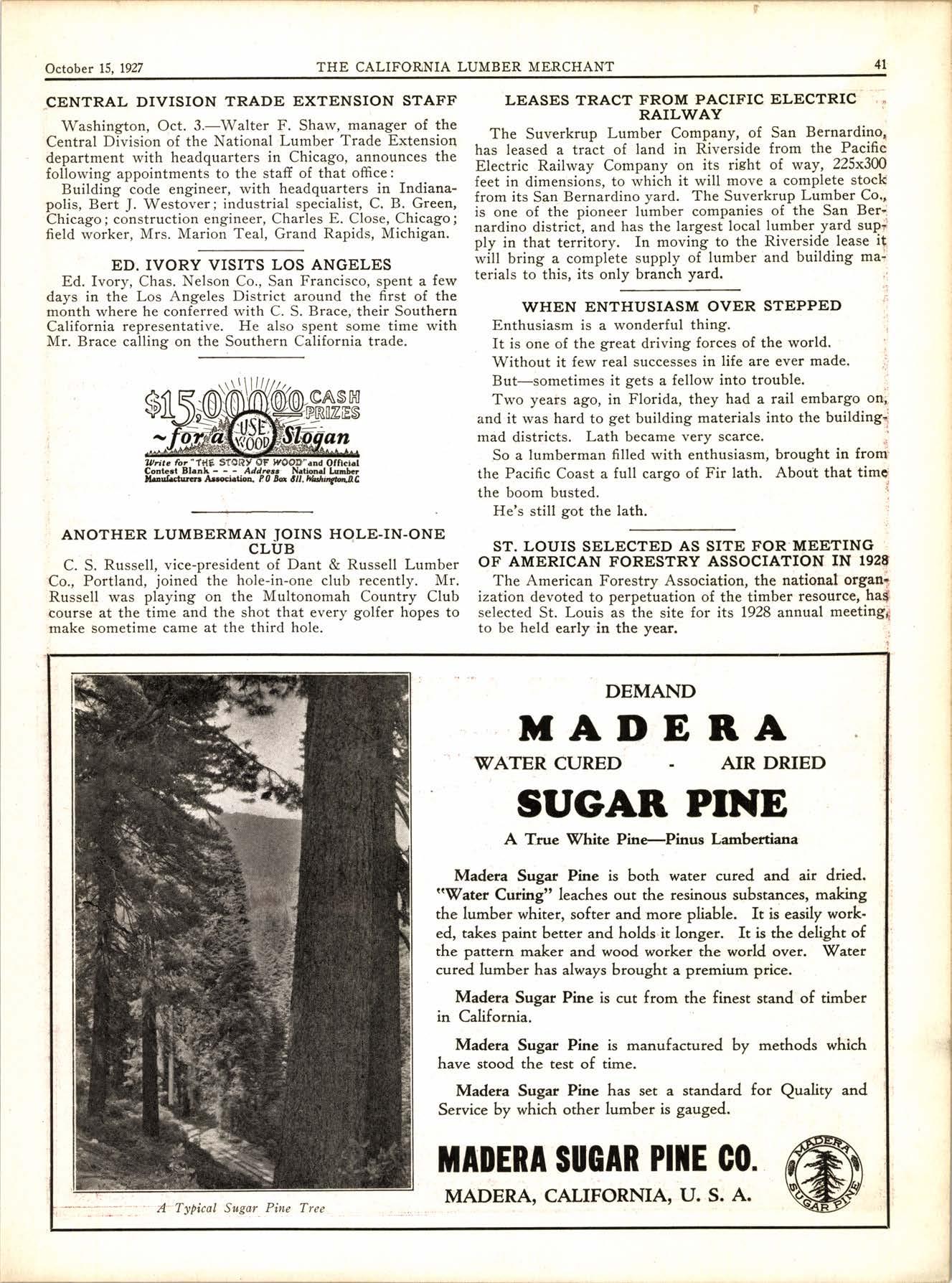
3 minute read
The Cooperative Lumber Trade Extension Program
The latest major, national cooperative trade extension campaign is that of the National Lumber Manufacturers' Association. Some three hundred of the leading soft-wood and hard-wood manufacturers and distributors in the United States and British Columbia, acting under the auspices of the National Lumber Manufacturersl Association, have subscribed a million dollars a year for five years, to the treasury of a united drive in the interest of lumber in competition with other building and industrial materials.
Necessity of Cooperation
Although many of the great lumber manufacturing corporations and regional associations of lumber manufacturers devoted to certain species of lumber have done a large amount of research, merchandising, promotion and advertising, it has been found that such particular undertakings do not meet the situation or covel the field. The rivals of lumber compete with it as lumber, not as varieties of lumber, and it has been found that advocacy of particular _kinds of lumber is not an adequate ofiensi or defense:. So, without in any way curtailing or interfering with their particular trade extension enterprises, the lum-bermen have undertaken a general campaign for lumber as a whole and without distinction of spicies.
directly employ about 1,200,000 persons, have an invested capital of approximately Ten Billion Dollars, and an annual output of around Four Billion Dollars. Besides being the chiefly used building material employed in the Unitea States and supplying three hundred ihousand out of four hundred thousand dwellings built each year, wood is the basic material of some seventy industrial groups and is neqessaty in almost all industries. It has bien ialled the 'indispensable material of civilization.
A Campaign of Research
The prosperity of sucli an extensive industry is obviously of importance to the whole business communitv of thL United States. The business world generally, t-herefore, will be interested in the five-year planlo re-invigorate thi lumber industry in all its branc[es. The camipaign includes scientific research bearing on reforestafion-, emplo-yment of hitherto neglected species of trees, economi_cal utilization, and such problems as the prevention of decay and the rendering of wood fireproof or'fire resistant. The research work wilfalso extend irito the manufacturing and merchandising fields. Three divisional trade exten"sion officers are being established-at Chicago, New york and San Francisco and some fifteen field 5ffices will be ope.ned in.as.many other cities. General headquarters remain in Washington.
contrary to the nli'"i:I
:trfrlnl""'rt.ing
iro* the conservation propaganda, there is at present in abundance of timber in the United. States, and the problem of future supply is orre of sufficient present consurirption rather than overuse. To_ preserve ripe trees, for example, is waste. In other words, the conservation movement lias'been overdone in that there is a tendency now to use too little wood instead of too much. The result is disastrous to forestry and tree growing, -which cannot flourish unless they ari on a sound basis of profit.
A Colossal Industrv
As the lumber industry is one noi greatly evident in cities many_people are quite unaware of"its eitent, as well as that of the other forest industries. The lumbir indus- try,. according to the criterion taken, stands second to :r_*!f 3Tong th: _great manufacturing industries of the unrted States. 'I'aken together with other forest industries it represents numerically, the greatest population g.;;;t t" the country, after agriculture.
It is estimated that about Twelve Million peoole are supported by forest industries and about Forty tttitiion Uy agriculture.
In their primary and second phases, the forest industries, and present status of the lumber industry as well as the valui of its unique ry.1t-eria_J, are set forth in a beautifully illustrated booklet, "The Story of 'Wood," issued in conjincti; ;i;h the extensive advertising program which is now introducing. the trade extension endeavor. The advertising plan includes the daily newspapers, national ,n"g"rirr"!, -"rJ yar.lojls class publications, but the advertising- of the con_ test for a distinctive slogan for the lumber industry, which is the publicity curtain--raiser, appears in the *;;"ri;;; and. class publications. The newipapers will be iivoked. rvrth the gpenrng of the chance to capitalize locally the fruits of the national slogan advertisine.
The histor," ,"..Ili, tlt'it:t"9,'?:;""".
Fifteen Thousand Doilars, in fifty-iven prizes, is of_ fered in prizes in the slogan contest,-and in order to ."t", !.he. co_ntest, it is necessary to get and read t;;; ;i "The Story of Wood." It is believed that in this #;v.; large portion of the public will be interested in the orieinal American industry -and its product and the sround';"_ pared for the ensuing intensive work of tfie five_year trade extension campaign, including the newspaper,'and. further magazine, advertising










